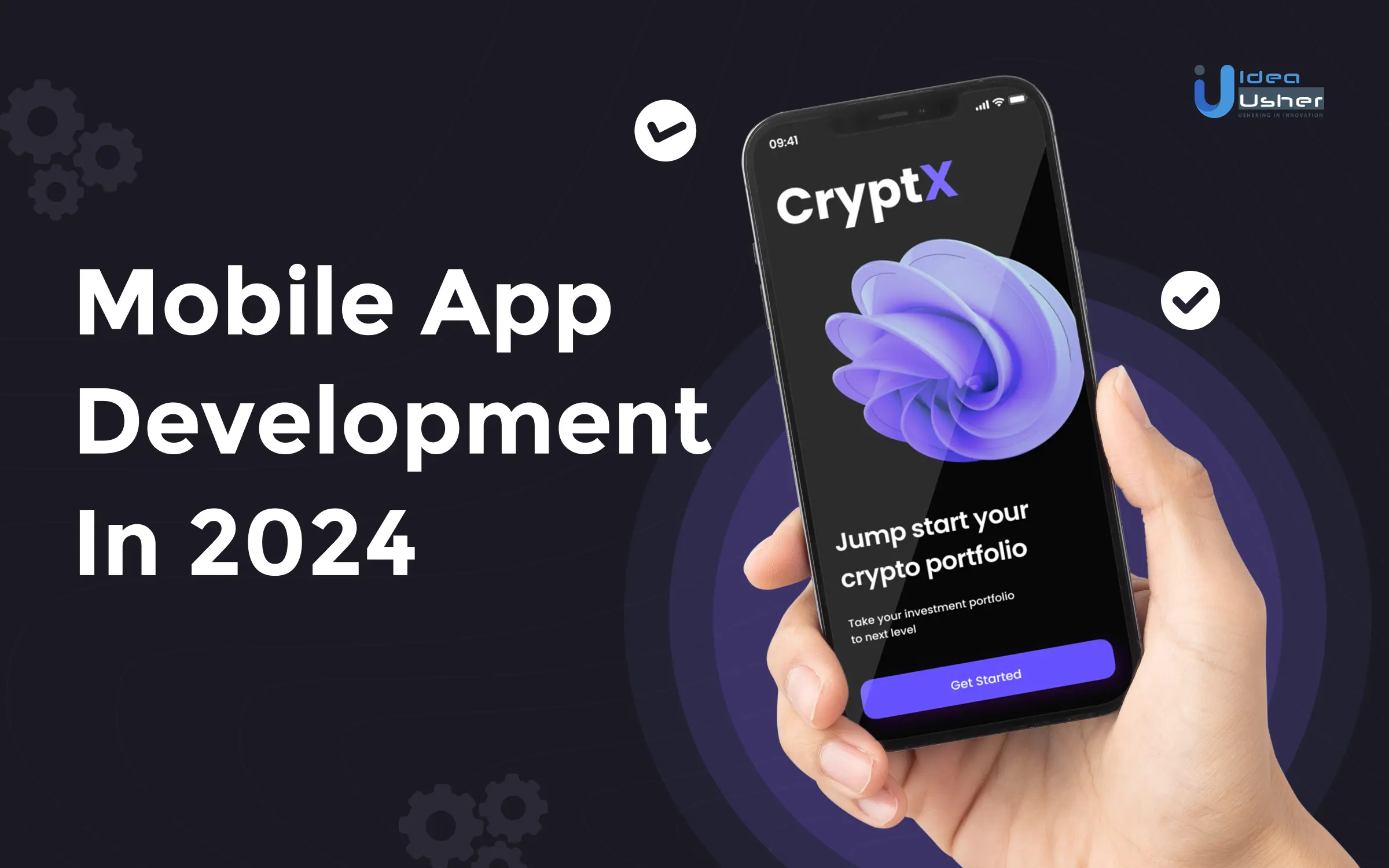
The mobile app development market is experiencing robust growth, presenting a lucrative opportunity for entrepreneurs and start-ups in the ever-evolving digital landscape. As we navigate through mobile app industry, the surge in the mobile app market signifies a growing path for business ventures.
Mobile app development offers a comprehensive benefit to company owners and entrepreneurs, such as from enhanced customer engagement to increased brand visibility. Custom mobile apps helps businesses aiming to stay competitive and relevant in the dynamic digital industry.
In this blog, discover how investing in a tailored mobile app can be a strategic move for entrepreneurs looking to capitalize on the thriving opportunities within the mobile app market in 2024.
- Mobile App Market Size Expected To Grow In 2024
- Business Benefits Of Mobile App Development In 2024
- Things To Consider Before Hiring A Mobile App Development Company
- How To Develop A Mobile App In 2024?
- What App Categories You Should Look For In 2024?
- Mobile Application Development Trends To Look In 2024
- Cost Affecting Factors To Consider To Develop A Custom Mobile App
- How Can Custom App Development Be Done Effectively?
- Tech Stack To Consider To Develop A Mobile App In 2024
- Conclusion
- FAQ
Mobile App Market Size Expected To Grow In 2024

Credits – Expert Market Research
The market for mobile app development is expanding rapidly. Investing in mobile app development offers great business potential for entrepreneurs and start-ups in the rapidly evolving digital economy.
- Through in-app purchases and paid downloads, mobile applications are expected to bring in over 935 billion dollars by 2023.
Business Benefits Of Mobile App Development In 2024
The successful integration of mobile applications has become essential, revolutionizing the way businesses interact with their customers and carry out business. Here are a few business benefits of mobile app development:
1. Enhanced Brand Awareness & Recognition
Mobile app development is a powerful tool for fostering brand awareness and customer communication. Regular interaction with your target audience helps in establishing trust and recognition.
An app provides a dedicated platform where customers can engage with your brand, learn about your products or services, and stay updated on promotions or news. This continuous presence on their mobile devices creates a lasting impression, contributing significantly to brand recall and loyalty.
2. Generating Additional Revenue Streams
Mobile app development becomes a strategic avenue for businesses to enhance customer satisfaction, leading to increased demand for products or services. A seamless and user-friendly app experience can positively influence customer perceptions, driving sales and revenue growth.
Additionally, mobile apps offer opportunities for in-app purchases, subscriptions, or exclusive deals, providing an additional revenue stream. Businesses can tailor offerings and promotions by analyzing customer behavior and preferences through the app, further boosting sales.
3. Offline Capability for Uninterrupted Access
A key advantage of mobile apps is their ability to function offline, differentiating them from mobile websites. While some tasks may still require internet connectivity, basic content and functionality can be accessed even without a network connection.
This offline capability ensures uninterrupted access to essential features, enhancing user convenience and satisfaction. This feature is especially valuable when users face network issues or have limited access, ensuring a consistent and reliable user experience.
4. Cost-Effective Marketing with Mobile-Specific Technologies
Mobile apps introduce a new dimension to marketing strategies, offering unique and cost-effective approaches. Geo-targeting, a mobile-specific technology, allows businesses to precisely target audiences based on their location, providing a personalized experience. This targeted approach, coupled with data-driven insights, enables businesses to optimize marketing efforts and reduce overall marketing costs.
By delivering relevant and timely information, businesses can build a stronger connection with their audience, increasing the likelihood of customer retention and repeat business.
5. Strengthening Customer Relations with Integrated Technology
The integration of chatbots and other customer-facing technologies within mobile apps significantly enhances customer service. Chatbots can efficiently handle frequently asked questions, provide product guidance, and offer support, thereby improving consumer trust and goodwill.
Businesses can establish themselves as customer-centric entities by leveraging technology to enhance customer interactions. This not only improves customer satisfaction but also strengthens the overall brand image.
6. Efficiency Gains and Cost Reductions in Service Delivery
Mobile app development not only improves customer-facing aspects but also streamlines internal processes, leading to efficiency gains and cost reductions. Tasks that traditionally required significant human resources can be automated through mobile apps. For example, a well-designed chatbot within the app can efficiently handle customer service inquiries, reducing the workload on human agents.
Beyond customer service, various other operational tasks can be streamlined, reducing the need for a large workforce. As a result, businesses can achieve cost savings by requiring fewer employees to perform the same tasks, ultimately contributing to a more efficient and agile organizational structure.
Things To Consider Before Hiring A Mobile App Development Company
Although launching a mobile app is not too difficult, marketing your app is far more crucial. Therefore, you might focus on the best aspects of your company with the assistance of mobile app developers for hire.
1. Experience
When selecting a mobile app development company or outsourcing a dedicated developer, the first crucial factor to consider is their experience and expertise. It’s essential to investigate their background, looking for developers with IT degrees and a proven track record in software development.
The depth of their experience will provide insights into their ability to handle diverse challenges and deliver a high-quality product. Additionally, consider checking client reviews and testimonials to gain a better understanding of their past performance and client satisfaction.
2. Process
The design and functionality of your mobile app play a crucial role in user perception. Therefore, it’s imperative to thoroughly discuss the design outline with the mobile app developers. Ensure that they follow a user-centered design approach, creating a user-friendly interface that aligns with your business objectives.
Moreover, understanding the development process is essential. A transparent and well-defined development process helps in managing expectations and timelines.
Discuss how they approach testing, feedback incorporation, and any iterative processes involved. This clarity ensures that the final product meets your requirements and industry standards.
3. Communication Between You And The Developers
Effective communication is the backbone of a successful collaboration between you and the developers. Without constant interaction and coordination, it’s challenging to create an app that perfectly aligns with your vision and goals.
Choose a development team that values open communication, providing regular updates on project milestones, challenges, and progress. Platforms and tools for communication should be agreed upon from the outset to ensure seamless interactions.
4. Cost
Before committing to a mobile app development project, carefully consider the cost involved. Evaluate the pricing structure provided by the development company or dedicated developer, ensuring it aligns with your budget and financial constraints. It’s essential to have a clear understanding of the entire package cost, including development, testing, and any additional services.
A higher upfront cost might be justified if the development team has a proven track record, advanced skills, and a comprehensive package that includes post-launch support and maintenance.
5. Post-Launch Services/ Maintenance And Support
Ensure that the development team provides a plan for regular updates, bug fixes, and potential feature enhancements. This commitment to continuous improvement is essential for keeping users engaged and satisfied.
Discuss the post-launch support framework, including response times for issue resolution and the process for handling unforeseen challenges. A reliable support system ensures that your app remains functional, secure, and up-to-date in the ever-evolving landscape of mobile technology.
6. Documentation
The legal aspect of your collaboration is critical for protecting your intellectual property and ensuring a clear understanding of the project’s ownership. Signing a Non-Disclosure Agreement (NDA) is mandatory.
This legal document explicitly outlines that you own the app, including the source code and content. It prevents the development company or dedicated developer from disclosing sensitive information to third parties and adds a layer of security to your project.
7. Level Of Involvement
Effective communication goes hand-in-hand with the level of involvement you desire in the development process. It’s important to establish from the beginning how hands-on or hands-off you want to be in different stages of development. A skilled development team should be able to adapt to your preferred level of involvement, providing regular updates and seeking your input when necessary.
Furthermore, an experienced development team should be adept at explaining complex technological concepts in simple language. This ensures that you, as the client, fully comprehend the technical aspects of the project without unnecessary jargon.
How To Develop A Mobile App In 2024?
Whether your goal is to develop a consumer-facing app, an enterprise solution, or the next breakthrough in mobile technology, this guide aims to equip you with the knowledge and tools needed to turn your ideas into reality. Here are the steps to build your mobile app
1. Defining a Clear Unique Value Proposition
Developing a mobile app requires a thoughtful approach, starting with a well-defined unique value proposition (UVP). Your UVP is the core of your app, the reason why users should choose it over others. It’s crucial to identify the purpose your app serves – whether it’s meeting consumer needs, solving a specific problem, or generating revenue.
Take the time to understand your target audience and what they value. Is it convenience, efficiency, entertainment, or a combination of these factors? Crafting a clear UVP not only guides your development process but also sets the stage for effective marketing later on.
2. Setting Goals and Performance Standards
Establishing standards ensures that your app meets quality benchmarks and user expectations. Whether your app introduces a groundbreaking concept or improves an existing one, having well-defined goals is crucial. This includes not only what you want to achieve with your app but also the performance metrics to measure success.
3. Establishing Target Audience
By defining user profiles, you’ll be better equipped to design an app that resonates with your audience as understanding your target audience is a cornerstone of successful app development. Before creating an app, ask yourself:
- Who your users are?
- What demographics do they fall into?
- What are their interests, needs, and pain points?
Utilize data to create detailed user profiles, mapping out their behaviors and preferences. This information is valuable in tailoring your app to meet user expectations and consider factors such as age, location, and technology proficiency.
4. Defining the Features of Your Mobile App
One of the pivotal stages in mobile app development is outlining the features that will make up your app. This involves creating a detailed list of functionalities necessary to achieve your app’s goals, often referred to as the Minimum Viable Product (MVP).
To kickstart this process, thorough market research is essential. Analyze competitor apps to understand what they offer, where they excel, and where they may be lacking. By identifying gaps in the market, you can innovate and provide solutions that set your app apart.
Offer required app features to align with your app’s purpose and user requirements, ensuring a comprehensive and user-friendly experience.
5. Securing Your Data
Safeguarding both your company’s confidential information and users’ data is crucial for building trust and ensuring compliance with privacy regulations. Implement robust security measures to protect against data breaches and unauthorized access.
Utilize encryption techniques, secure authentication processes, and stay informed about the latest security standards. Prioritize data security not only as a feature but as a fundamental aspect of your mobile app’s architecture.
6. Deciding How You Will Generate Data
Generating meaningful data requires thoughtful planning. Consider what metrics are essential for evaluating your app’s performance and user engagement. This could include user behavior analytics, demographics, and interaction patterns. Implement analytics tools to gather insights into user preferences and app usage.
Use this data to refine your app, identify areas for improvement, and make informed decisions for future updates. Remember, a well-considered data generation strategy ensures that your app not only meets current needs but evolves to stay relevant in the dynamic app landscape.
7. Choosing a Monetization Strategy
Selecting the right monetization strategy is a critical decision that influences the financial success of your mobile app. Here are some popular strategies to consider:
A. Advertising
Advertising is a widespread monetization strategy where app owners earn revenue by displaying third-party ads within their mobile applications. This model can be applied to various app types, provided there is an active user base. In-app advertising can take various forms, such as banner ads, interstitial ads, or native ads.
B. Affiliate Marketing
Affiliate marketing involves collaborating with apps with a similar user base, creating a mutually beneficial arrangement. By promoting each other’s products or services, both parties can enhance their offerings and engage a broader audience.
C. Lead Generation
Lead generation is a monetization strategy that involves capturing the attention of potential customers through advertising and then selling these leads to other interested parties. This model is particularly effective when your app has valuable user data that can be leveraged by businesses in related industries.
D. Transaction Fees:
Transaction fees are charges imposed on users each time an electronic payment is processed through the app. This strategy is common in platforms that facilitate financial transactions, such as payment gateways or peer-to-peer transaction apps.
E. Freemium:
The freemium model offers the app’s core functionality for free but requires payment for premium features or additional content. This approach allows users to experience the basic features of the app before deciding to invest in enhanced capabilities.
F. In-App Purchases:
In-app purchases involve selling physical or virtual goods within the app, often used in gaming applications. Users can enhance their experience or progress in the game by purchasing items, upgrades, or additional content.
G. Subscription
Similar to freemium, the subscription model restricts access to certain content until users subscribe. This approach is commonly seen in content-based apps, such as streaming services, news, or educational platforms.
What App Categories You Should Look For In 2024?
Identifying the specific category of app you want to develop lays the foundation for making informed decisions about the most suitable development platform.
1. Healthcare Apps
Healthcare apps have revolutionized personal wellness by providing tailored solutions for individuals. Beyond serving as repositories for medical information, these apps offer simple exercise routines customized to meet specific needs. Whether it’s tracking daily activity, setting fitness goals, or guiding users through personalized workouts, healthcare apps play a crucial role in promoting a healthier lifestyle. With the convenience of accessing fitness routines at any time, users can engage in physical activity based on their individual preferences and requirements.
Example: Zocdoc
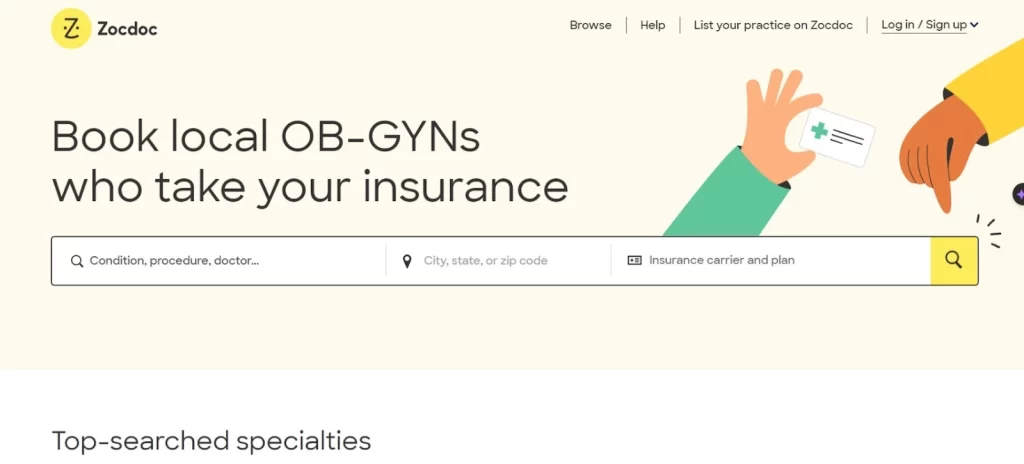
Zocdoc is a healthcare app that facilitates streamlined access to medical care by allowing users to schedule appointments with a wide range of healthcare professionals. The app covers various healthcare specialties, including primary care, dentistry. dermatology, and more.
2. Manufacturing Apps
The manufacturing sector has witnessed significant advancements in mobile app development, making the adoption of new technologies and tools more accessible. One notable example is the use of low-code platforms, which are rapid app development tools enabling organizations to create custom applications efficiently and cost-effectively. These apps streamline various manufacturing processes, from inventory management to quality control. By leveraging technology, manufacturing apps contribute to increased efficiency, reduced costs, and improved overall productivity within the industry.
Example: Microsoft Dynamics 365
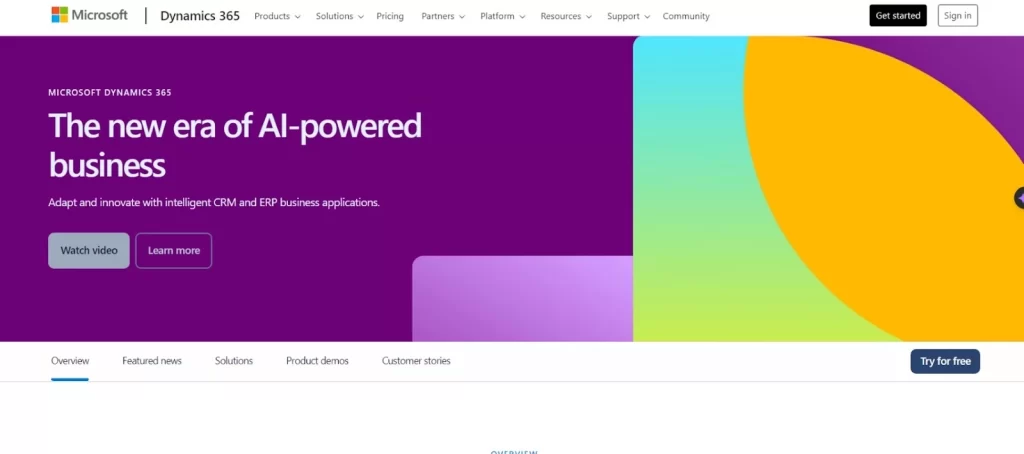
Microsoft Dynamics 365 in manufacturing is a comprehensive business solution designed to empower manufacturing organizations with end-to-end capabilities for seamless operations.
The app allows businesses to centralize their data, automate processes, and gain insights into customer interactions.
3. Logistics Apps
Logistics companies face the challenge of managing fleets and warehouses efficiently to ensure smooth operations. Mobile applications tailored for logistics play a pivotal role in automating and optimizing fleet and warehouse management. These apps enable real-time tracking of shipments, efficient route planning, and streamlined inventory management. By automating complex supply chain processes, logistics apps contribute to time and cost savings,
allowing companies to scale their operations seamlessly.
Example: FlexPort
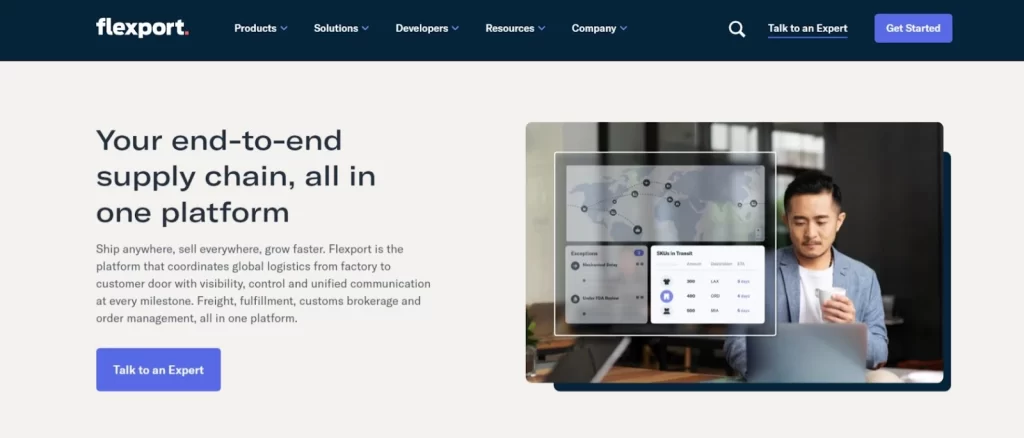
Flexport is a digital freight forwarding and logistics platform that facilitates international shipping and trade. The Flexport app streamlines the complex process of global logistics by providing end-to-end visibility and management capabilities for businesses involved in international trade.
4. Retail Apps
In the retail industry, the two major trends shaping the future are customization and personalization. Retail apps are at the forefront of this evolution, offering personalized shopping experiences tailored to individual preferences. As we look beyond 2024, the rise of headless commerce is anticipated, further increasing the demand for skilled mobile app developers. This trend emphasizes the separation of the front-end and back-end of an e-commerce application, providing flexibility and agility in delivering unique and tailored retail experiences to consumers.
Example: Amazon
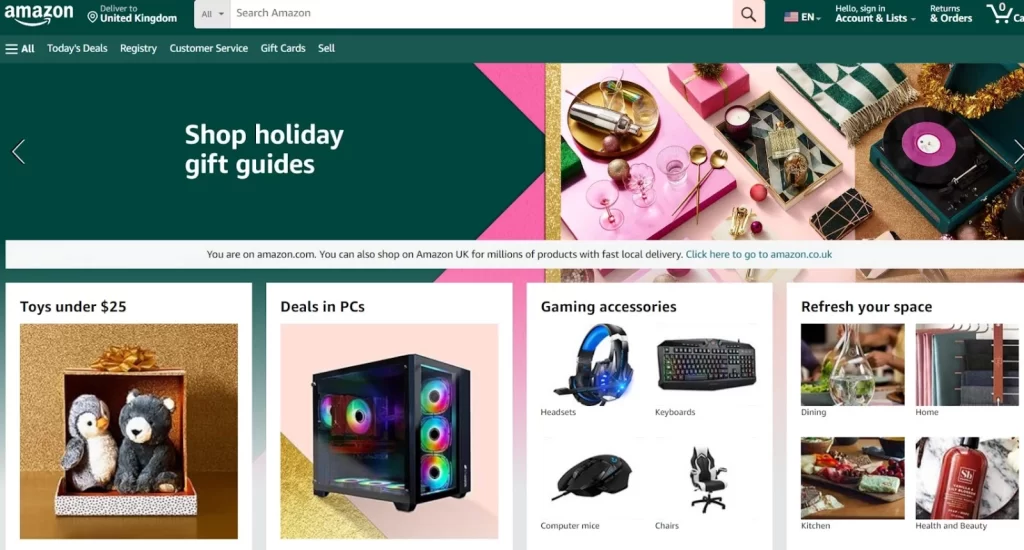
The Amazon app is a mobile application developed by Amazon, one of the world’s largest e-commerce and technology companies. Available on various platforms such as iOS and Android, the app provides users with a seamless and convenient way to browse, shop, and manage their Amazon accounts from their mobile devices. Offering a user-friendly interface, the Amazon app enables customers to explore an extensive range of products, read product reviews, and make secure purchases with just a few taps.
5. E-learning Apps
The lockdown period significantly increased the usage of e-learning apps as students sought alternative ways to continue their education remotely. These apps provide a diverse range of educational resources, interactive lessons, and assessments, allowing students to learn at their own pace. E-learning apps have become essential tools for both formal education and skill development, offering a convenient and accessible platform for individuals of all ages to enhance their knowledge and skills.
Example: Udemy

Udemy mobile app allows users to access a vast array of online courses covering diverse subjects such as technology, business, personal development, and more. With a user-friendly interface, the Udemy app provides learners with the flexibility to take courses at their own pace, anywhere and anytime.
6. Financial Apps
Financial apps play a pivotal role in everyday transactions, from making and receiving payments to facilitating investments and banking activities. These apps provide users with convenient and secure platforms for managing their finances on the go. Additionally, financial apps cater to the growing interest in stock market investments and cryptocurrencies, offering users the ability to monitor market trends, make informed investment decisions, and execute transactions seamlessly.
Example: RobinHood
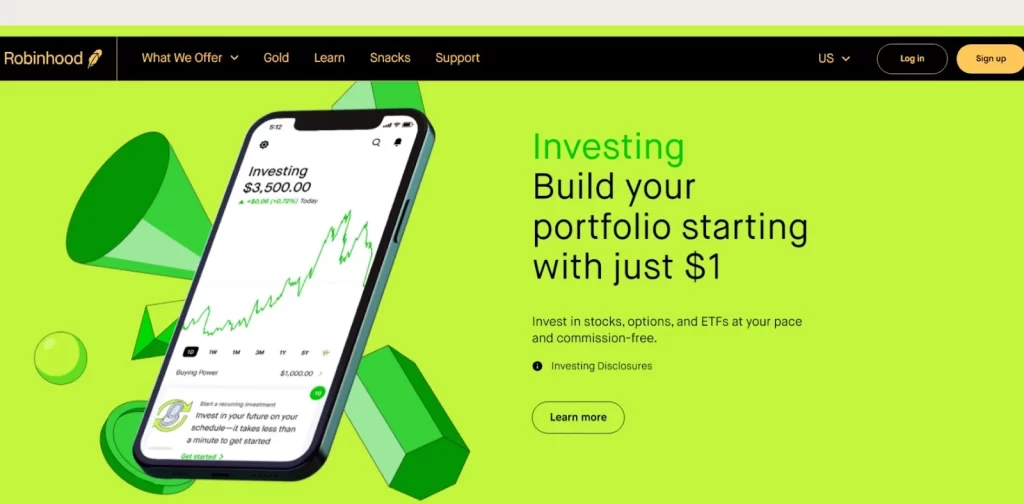
The investment platform Robinhood is well-known for enabling more people to enter the financial markets. With no typical brokerage costs, users may purchase and sell stocks, exchange-traded funds (ETFs), options, and cryptocurrencies using the Robinhood app, which was released in 2013.
7. Media Apps
Media apps cater to the entertainment needs of smartphone users, allowing them to plug in their headphones and enjoy music or visual content on the go. These apps provide access to a vast library of songs, podcasts, videos, and more, offering a personalized and immersive entertainment experience. With features like offline playback and curated playlists, media apps enhance the overall enjoyment of digital content, making them a staple on every smartphone.
Example: Netflix

Netflix enable streamers to enjoy a vast collection of films, TV series, documentaries, and original material straight on their devices. The Netflix app offers customers a personalised viewing experience with its user-friendly design, which suggests material based on their viewing interests and history.
8. Food and Hospitality
For those looking to develop a lucrative app, the food and hospitality category remains immensely popular. Collaborating with experienced hospitality app development companies can open doors to creating innovative solutions for food delivery, restaurant reservations, and personalized dining experiences. With the rise of on-demand services, a well-designed food and hospitality app can attract a broad user base, offering convenience and quality service in the competitive market.
Example: Uber Eats
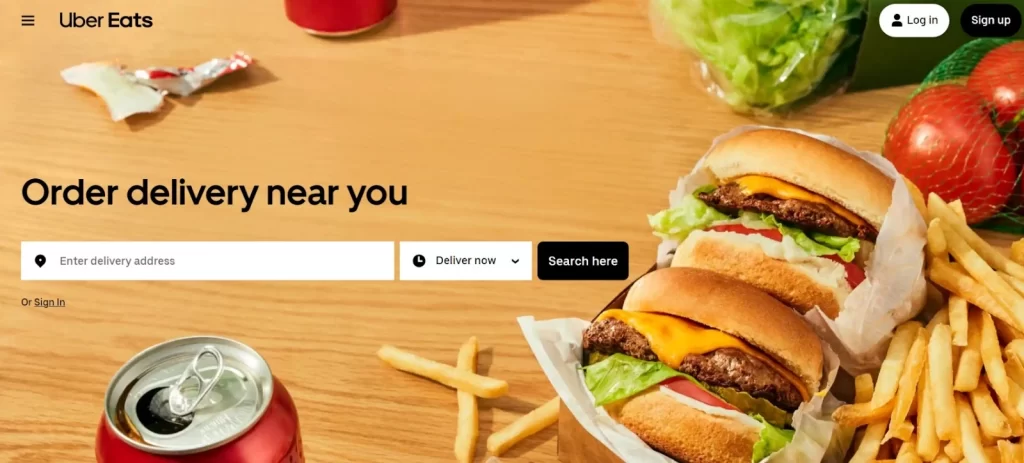
Uber Eats is a food delivery service run by Uber Technologies that offers customers the option of conveniently ordering takeaway from nearby restaurants and having it delivered right to their door. Uber Eats is a stand-alone application for smartphones that lets users browse a wide variety of cuisines, look through restaurant menus, and easily place orders.
Mobile Application Development Trends To Look In 2024
In order to succeed in digital media, smartphones are swiftly emerging as the most important instrument. At an incredible pace, it radically alters market dynamics, corporate structures, and operational plans. The predicted income from mobile apps is $693 billion by 2024.
Let’s take a closer look at some of the latest trends.
1. Foldable Devices
As foldable devices gain traction, app developers are faced with the exciting challenge of adapting to dynamic screen configurations. These devices offer users a unique and versatile experience, transitioning seamlessly between various form factors. To ensure a smooth user experience, developers must prioritize flexible design principles. This involves creating interfaces that can adapt to different screen sizes, resolutions, and folding patterns. By embracing responsive design and optimizing layouts for foldable screens, developers can enhance usability and capitalize on the innovative potential of these devices. The goal is to provide users with consistent and intuitive interactions, regardless of how they choose to unfold their devices.
Additionally, leveraging foldable technology opens up new possibilities for multitasking and creative user interfaces. Developers can explore innovative ways to utilize the expanded screen real estate, such as split-screen functionalities or task-specific layouts. Embracing the capabilities of foldable devices not only future-proofs applications but also offers users a more immersive and enjoyable mobile experience.
2. The Metaverse
The metaverse is rapidly evolving from a concept rooted in virtual reality and social media into a central aspect of our digital lives. App developers are now presented with the opportunity to create immersive experiences within this interconnected digital universe. Metaverse apps go beyond traditional boundaries, providing users with a platform to interact, socialize, and engage in ways previously unimaginable. From virtual gatherings to collaborative workspaces, the metaverse is becoming a hub for diverse activities.
To tap into the potential of the metaverse, developers need to focus on creating apps that seamlessly integrate with this expansive digital space. This involves incorporating virtual reality elements, social connectivity features, and customizable avatars. As the metaverse continues to grow, developers must stay attuned to emerging technologies and standards, ensuring their applications remain relevant and offer users an engaging and evolving experience within this vast digital landscape. The metaverse represents a paradigm shift in how we interact with digital content, and app developers play a crucial role in shaping this transformative space.
3. AI-Driven User Interfaces
Artificial Intelligence (AI) is increasingly becoming a driving force in mobile app development, reshaping the way users interact with applications. AI-driven user interfaces offer personalized experiences, adapting to individual preferences and behavior patterns. Through machine learning algorithms, apps can learn from user interactions, anticipate needs, and provide tailored recommendations. This level of personalization enhances user satisfaction and engagement, creating a more seamless and efficient mobile experience.
Developers integrating AI into their applications can explore features such as predictive text, smart recommendations, and context-aware interfaces. The goal is to make apps more intuitive and user-friendly, reducing friction in navigation and decision-making processes. As AI technology continues to advance, its integration into mobile app development will likely expand, offering users increasingly sophisticated and personalized interactions with their devices.
4. Super Apps
The era of single-purpose apps is evolving into a landscape dominated by super apps that offer a myriad of functionalities within a single platform. Users now seek comprehensive solutions that address multiple needs, from communication and entertainment to productivity and shopping. Super apps consolidate diverse services, providing a one-stop-shop for users to access various functionalities without switching between multiple applications.
Developers aiming to create super apps should focus on seamless integration of services, ensuring a cohesive user experience. This involves optimizing navigation, streamlining workflows, and maintaining a consistent design language throughout the app. By offering a holistic solution, super apps have the potential to become indispensable tools in users’ daily lives, fostering loyalty and engagement. The trend towards super apps reflects a shift in user expectations, emphasizing convenience and efficiency in the digital landscape.
5. Mobile Learning
Mobile learning (M-learning) is a prominent trend in mobile app development, catering to the growing demand for accessible and flexible educational resources. With the ubiquity of smartphones, users can engage in learning activities anytime, anywhere. M-learning apps leverage mobile technology to deliver educational content in various formats, such as video lectures, interactive quizzes, and collaborative forums.
Developers in the M-learning space should prioritize user-friendly interfaces and intuitive navigation to enhance the learning experience. Incorporating features like progress tracking, personalized learning paths, and offline access ensures that users can seamlessly integrate learning into their daily routines. As the demand for continuous learning grows, M-learning apps play a pivotal role in democratizing education, making knowledge readily available to a global audience.
6. Rise of 5G
The advent of 5G technology is set to revolutionize mobile app development by ushering in unparalleled speed and reliability. With faster data transfer rates and lower latency, 5G enables a new era of connectivity that opens up possibilities for enhanced user experiences. Developers can leverage the capabilities of 5G to deliver high-quality streaming, real-time collaboration, and immersive content without the constraints of slower networks.
To capitalize on the benefits of 5G, developers must optimize their apps for improved performance, taking advantage of the increased bandwidth to deliver richer multimedia experiences. From augmented reality (AR) applications to high-definition video streaming, the era of 5G introduces a new level of interactivity and responsiveness in mobile apps. As 5G networks continue to expand globally, developers play a crucial role in harnessing this transformative technology to create cutting-edge mobile experiences.
7. Voice Technology
Voice recognition technology is evolving rapidly, leading to the rise of voice-activated apps that streamline user interactions. From virtual assistants to hands-free navigation, voice technology offers a hands-free and efficient way for users to engage with their devices. Developers integrating voice features into their apps should prioritize natural language processing, accuracy, and context-aware responses to ensure a seamless user experience.
Voice-activated apps find applications across various domains, from voice commands in smart homes to dictation features in productivity apps. As the technology matures, developers can explore innovative ways to leverage voice interfaces, making apps more accessible and user-friendly. The trend towards voice technology aligns with the growing preference for intuitive and convenient interactions, marking a significant shift in how users engage with mobile applications.
8. AR & VR Technology
Augmented Reality (AR) and Virtual Reality (VR) technologies are no longer confined to niche applications but are becoming integral components of mainstream mobile apps. These immersive technologies enhance user experiences by overlaying digital elements onto the real world (AR) or creating entirely virtual environments (VR). From gaming and entertainment to retail and education, AR and VR open up new dimensions of interactivity and engagement.
Developers venturing into AR and VR app development should focus on creating seamless and realistic experiences. This involves optimizing graphics, ensuring smooth interactions, and incorporating features that leverage the unique capabilities of these technologies. As hardware devices supporting AR and VR become more accessible, developers have the opportunity to captivate users with innovative and immersive mobile applications, creating experiences that go beyond traditional screen interactions. The rise of AR and VR signifies a shift towards more engaging and interactive digital experiences in the mobile app landscape.
Cost Affecting Factors To Consider To Develop A Custom Mobile App
The budget and app success are mostly determined by the various components that go into creating an app, such as integrating third-party services, building a strong backend, adding in-app purchases, and supporting a variety of hardware setups.
Consider the following factors to develop a custom mobile app.Necessary.
1. Third-party Integration
When estimating the cost of developing a custom mobile app, third-party integration stands out as a critical factor. Integrating third-party services, libraries, and frameworks becomes necessary for various functionalities.
For instance, if your app involves payment transactions, you may need to integrate payment services like Braintree or Stripe. Additionally, social media sharing capabilities may require integration with APIs from platforms like Facebook or Twitter. While third-party integrations enhance the app’s features and user experience, they contribute to the overall complexity and cost of development.
The cost implications of third-party integration involve not only the initial setup but also ongoing maintenance and updates to ensure compatibility with evolving external services.
2. Developing The Backend
A crucial aspect influencing the cost of custom mobile app development is the creation of the backend infrastructure. The backend serves as the powerhouse, connecting the app’s frontend with the content and ensuring smooth functionality.
The cost considerations for backend development include the expertise and experience of the backend developer, the complexity of the required server-side operations, and the scale of the app’s content management system (CMS).
A robust and well-designed backend is essential for delivering a seamless user experience, handling data securely, and supporting future scalability. However, investing in a skilled backend developer and building a powerful backend infrastructure is a vital component that adds to the overall budget of custom mobile app development.
3. In-App Purchases
In-app purchases are a significant factor influencing the cost and complexity of custom mobile app development. These purchases can take various forms, from unlocking additional features to buying virtual products within the app. The inclusion of in-app purchases adds a layer of technical complexity, requiring developers to implement secure payment gateways and design seamless user interfaces for purchase interactions.
The cost implications of in-app purchases extend beyond the initial development phase. Ongoing maintenance and updates are necessary to manage and enhance the in-app purchasing system, ensuring it remains secure and compliant with payment regulations. The diversity of in-app purchase options, from one-time purchases to subscription models, adds to the overall technical complexity.
4. Incorporating Hardware Components
The diverse range of devices and manufacturers in the mobile ecosystem introduces variability in hardware components. When developing a custom mobile app, the integration of hardware components specific to each device type and manufacturer becomes a crucial factor. This includes strategies for communication with various hardware elements, such as cameras, sensors, or biometric features, depending on the app’s requirements.
Incorporating hardware components raises both development costs and time requirements. Developers need to tailor the app’s functionality to align with the specifications of different devices, ensuring seamless communication with various hardware elements.
This process involves thorough testing to verify compatibility and functionality across a spectrum of devices. The need for specialized strategies for each device type adds intricacy to the development process, influencing both the budget and timeline of custom mobile app development.
How Can Custom App Development Be Done Effectively?
From choosing an outsourcing partner to strategically deploying the MVP there are several factors that plays a part in making sure the product succeeds overall and appeals to customers while providing real value in a cutthroat digital market.
1. Choosing the Right Outsourcing Partner
When venturing into custom app development, outsourcing can be a strategic move to harness external expertise. To ensure success, it’s crucial to carefully choose a service provider.
Begin by conducting a thorough comparison of potential vendors, evaluating their services, capabilities, and pricing models. Look for a partner with a track record of delivering high-quality mobile apps within budget and on schedule. Client testimonials and case studies can provide valuable insights into a company’s performance.
Additionally, consider the geographical location of the outsourcing partner, as time zone differences can impact communication and project coordination. Establish clear communication channels and expectations from the outset to foster a collaborative and transparent development process.
2. Strategic Implementation of MVP (Minimum Viable Product)
In custom app development, creating a Minimum Viable Product (MVP) serves as a pivotal step towards both testing the market and defining the app’s core features. The first objective of an MVP is to validate the viability of your app concept in the real market scenario.
By releasing a simplified version, you can gather valuable user feedback and assess whether your app genuinely addresses user needs and solves existing problems. This early validation helps in avoiding substantial investments in a full-fledged app that may not resonate with the target audience.
The second goal of MVP development is to identify and prioritize key features that align with your unique value proposition. During this stage, it’s crucial to resist the temptation to include unnecessary functionalities that might distract from the core purpose of the app. Instead, focus on functionalities that deliver tangible value to users and contribute to the overall user experience.
Tech Stack To Consider To Develop A Mobile App In 2024
Developing a mobile app involves using a variety of tools, frameworks, and platforms to streamline the development process. Here are some commonly used tools across different stages of mobile app development:
1. Integrated Development Environments (IDEs)
- Android Studio
- Xcode
2. Cross-Platform Development Frameworks
- React Native
- Flutter
- Xamarin
3. App Prototyping and Design
- Sketch
- Adobe XD
4. Version Control
- Git
5. Backend Development
- Firebase
- Node.js
- Django
6. Database Management
- SQLite
- MongoDB
7. Testing and Debugging
- Appium
- XCTest
- Espresso
8. Continuous Integration and Deployment (CI/CD)
- Jenkins
- Travis CI
9. Project Management and Collaboration
- Jira
- Slack
10. Performance Monitoring
- New Relic
11. Security Testing
- OWASP ZAP
12. Analytics
- Google Analytics
Conclusion
Your app development will be successful if you collaborate with a business that has expertise in creating mobile applications. Both inexpensive and high-quality app development may support business expansion. The tech stack and features of your app determine its quality.
Expert App Developers provide scalability with their proficiency in application consulting, UI/UX design, testing, and deployment.
Obtain tested solutions for customized mobile app development and work with our experts to give your business a competitive edge.
Our app developers will do a complete requirements assessment with you and your business before we develop a mobile app that suits your demands. Our team creates secure, scalable, and user-friendly digital platforms by utilizing industry best practices and cutting-edge technology.
To find out more about how our app development services may assist you in launching and expanding your business, give us a call right now.
FAQ
Q. What are the app development trends 2024?
A. Internet of Things (IoT), 5G Technology, Augmented Reality and Virtual Reality, Predictive Analytics, Artificial Intelligence and Machine Learning, Metaverse, Blockchain Integration, Beacon Technology, and On-demand Apps are some app development trends in 2024.
Q. Does mobile app development have a future?
A. Yes, According to a new analysis released by GlobeNewsWire, the mobile application market is expected to increase at a compound annual growth rate (CAGR) of 13.5% from 2022 to 2030, from an anticipated $207.31 billion in revenue in 2022 to $571.62 billion by 2030.
Q. How to develop a mobile app?
A. A mobile application can be developed by following the steps such as defining the app purpose, identifying business key priorities, establishing project scope, specifying target audience & expectations, and planning to develop an app.
Q. How much does it cost to develop a mobile app?
A. There are several factors that affect the cost of developing an app such as third-party integration, developing the backend, in-app purchases and incorporating hardware components.










Gaurav Patil